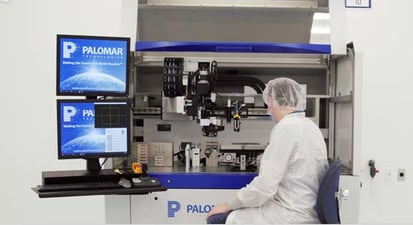A well-known Danish Children’s toy company, with theme parks around the world, has recently launched its latest product aimed at grown-ups, comprising a 1:200 scaled model of the famed liner, Titanic. Actually, that is not quite true, they’re selling a set of over 9,000 individual pieces that the owner must self-assemble following 1,000 pages of full-detailed, diagrammatic illustrations. Other than the brand name, the instructions do not contain a word of English. In fact, there are no words at all, unless you count the name of the ship. All credit then to the engineer’s ability to so effectively support and convey the principles of product design and build. Finally, and despite being priced around the level of a piece of high-end audio equipment, demand is facing a significant back-log.
Patented in 1958, the company’s most famous product is a simple building block. It’s first brilliance lies in the ingenious interlocking principles. The latter were not only then unique, but allowed for unlimited creativity to emerge through play. It’s second brilliance is an almost infinite agility allowing engagement and connection and an ability to mirror real time technological advances in the child’s and indeed adults, world. Thus, the product has built on its core definitives over the years. Finally, there is an ability to create models that anticipate—even facilitate—the future of real technology.
Given what we have said, it should be no surprise that a variety of global research and development centers utilize this product in their design and solutions work. From automotive to aerospace, from uses in the Secret Service to software, this toy is anything but. Perhaps the product’s greatest affirmation, however, lies in the fact that North America’s top-ranking technical university has an Endowed Chair named after it. Conversely, the most bizarre aspect of influence must be the haircut style the toy has inspired from some of its characters.
The world of die bonders bears unfamiliar—though not inexplicable—comparison. The only difference is that the machine acts as an intermediate tool between human and brick. If the former has unlimited creativity, and the latter unlimited potential, the only need is for the chosen machine to match the underlying intent. Some “model” builders prefer following a common format, producing as many end-products as possible, but within tightly defined parameters of design latitude. These tend to work in high-volume markets tightly aligned to the growth (but not technical) dynamics of the wider eco-system. Others are either more creative and less settled on their final “model” or uncertain as to which technical dynamic to follow, or, indeed, suits best their overall business strategy. Indeed, they may want permanent latitude here. Finally, there are those whose end-products are new to the market place, and may still need to change fundamentals in packaging technology in order to gain optimum commercial traction.
Palomar die bonding systems are well known for their versatility together with their ability to meet the requirements of dynamic and agile packaging needs. These machines are particularly suited to low volume, high-value products, especially those making a market-place debut. What is less appreciated, however, is what we may term their “ingenious interlocking system”, their ability to seamlessly interconnect with other bonding approaches or, indeed, other elements of the packaging process requiring, as in a number of critically sealed medical devices, vacuum reflow. Similarly, our wire bonders offer unique and effective “stitching” on the smallest of scales owing to their z-axis being able to match exacting planarity, thus avoiding any wire-impacted distortions. On the smallest of scales, failure here can only contribute towards undermining long-term device dependability.
Our die bonder’s strongest association with the Danish toy, however, must be that while our products are strongly associated with the semi-conductor industry, they have considerably more wide-spread application. Their underlying capabilities have profound equivalence to our building block analogy. The 3880-II, for example, has the ability to construct—or more correctly micro-construct—almost any physical device. As energy and technical needs push varying sectors to building with new materials and mixes of materials, even, wholly man-made compounds, such potentials are increasing exponentially. These can be completely electrically inert; some merely need to be “grown” through deposition, then picked up and placed—but, with extreme care and precision. Such processes are not restricted to the world of engineering technology, but where consumer preference is for responsibly sourced or made-made alternatives to very high-value products. Where there is dual application, these two streams coalesce.
products are strongly associated with the semi-conductor industry, they have considerably more wide-spread application. Their underlying capabilities have profound equivalence to our building block analogy. The 3880-II, for example, has the ability to construct—or more correctly micro-construct—almost any physical device. As energy and technical needs push varying sectors to building with new materials and mixes of materials, even, wholly man-made compounds, such potentials are increasing exponentially. These can be completely electrically inert; some merely need to be “grown” through deposition, then picked up and placed—but, with extreme care and precision. Such processes are not restricted to the world of engineering technology, but where consumer preference is for responsibly sourced or made-made alternatives to very high-value products. Where there is dual application, these two streams coalesce.
Increased realizable opportunities are no mystery. The principles of the physical world are such that all solutions of the possible work algorithmically; a goal is reached by a succession of logical actions. The genius is to identify these and then follow them in order to achieve the intended goal. With this in mind, Palomar’s range of systems must be viewed at the epicenter of creative solutions, limited only by the laws of physics and understanding of machine capabilities. For this reason, we will be making available detailed and highly practical, range of training materials for our machines aiming at securing diverse outcomes. These will range from technician centered instructions aimed at maximizing efficiency of output, to those supporting highly advanced experimental packaging solutions for next generation devices and beyond.